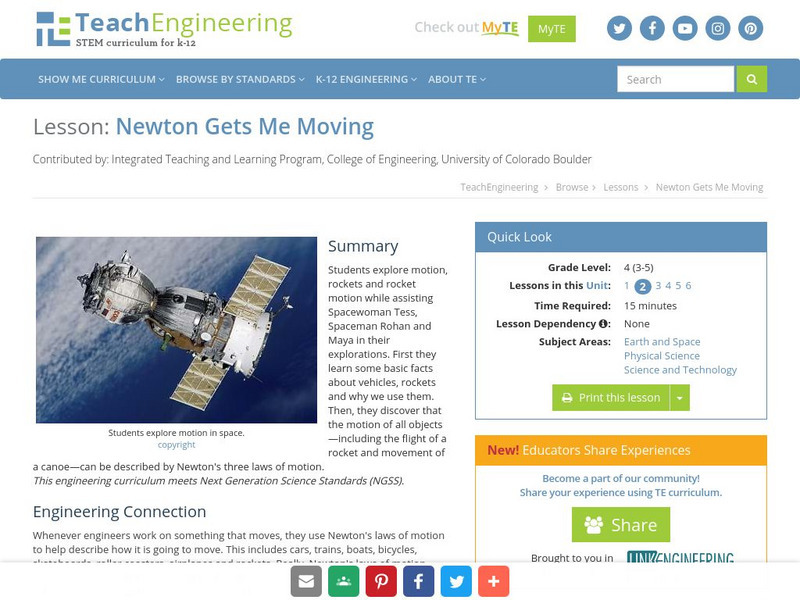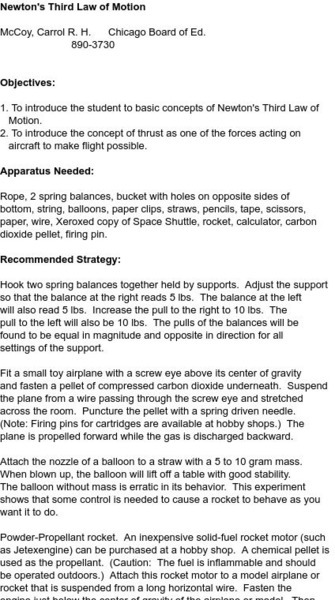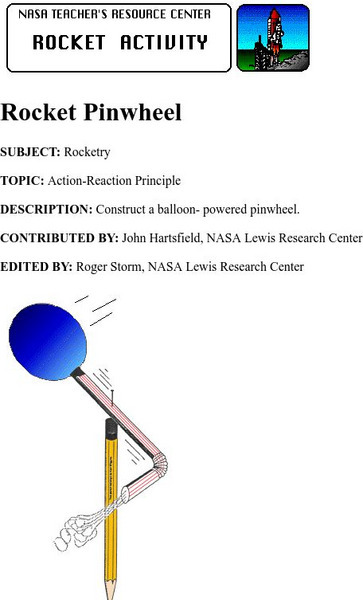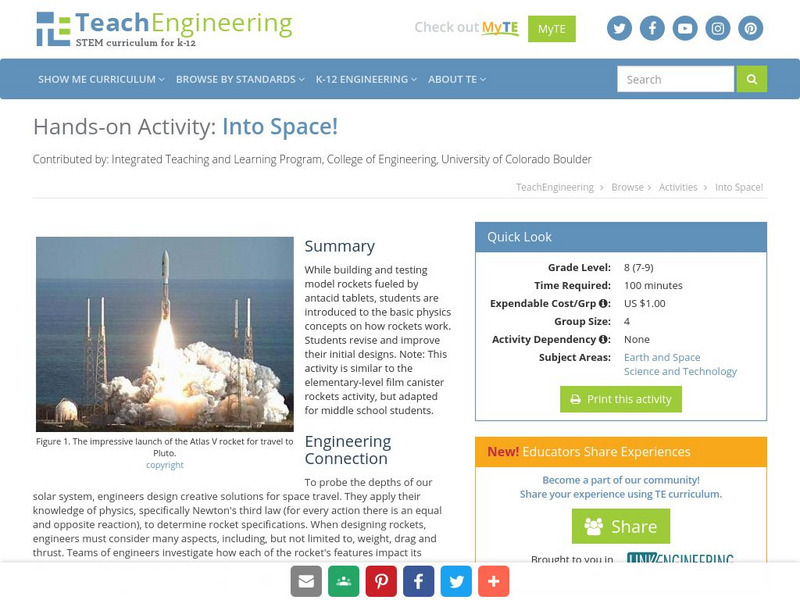NASA
Nasa: Rockets Educator Guide: Applying Newton's Laws
Learn how Newton's Laws apply to rocketry. Discover how rockets work, including the engines and propellants.
TeachEngineering
Teach Engineering: Newton Gets Me Moving
In this instructional activity, learners will explore motion, rockets and rocket motion while assisting Spacewoman Tess, Spaceman Rohan and Maya in their explorations. They will first learn some basic facts about vehicles, rockets and...
Texas Education Agency
Texas Gateway: Linear Momentum and Force: Introduction to Rocket Propulsion
By the end of this section, you will be able to state Newton's third law of motion, explain the principle involved in propulsion of rockets and jet engines, derive an expression for the acceleration of the rocket , discuss the factors...
NASA
Nasa: Rockets Educator Guide: Newton Car
This lesson gives students direction on how to experiment using gravity and force. Students will make a wooden car and use different forces to make the car propel.
TeachEngineering
Teach Engineering: Rocket Me Into Space
One of the exciting challenges for engineers is the idea of exploration. This lesson looks more closely at Spaceman Rohan, Spacewoman Tess, their daughter Maya, and their challenges with getting to space, setting up satellites, and...
NASA
Ltp: Rocket Principles
Excellent NASA sponsored site on the principles of rockets. The site relates Newton's 3 laws to the flight of a rocket. Site also has links to activities related to rockets in addition to links about practical rocketry.
NASA
Nasa: Rockets Educator Guide: How Rockets Work
In this article, learn how rockets work. Discover Newton's Law of Motion and learn how it supports rocketry.
TeachEngineering
Teach Engineering: Houston, We Have a Problem!
Students apply their mathematics and team building skills to explore the concept of rocketry.Throughout the design process, teamwork is emphasized since the most successful launches occur when groups work effectively to generate creative...
TeachEngineering
Teach Engineering: Rocket Power
By making and testing simple balloon rockets, students acquire a basic understanding of Newton's third law of motion as it applies to rockets. Using balloons, string, straws and tape, they see how rockets are propelled by expelling...
South Carolina Educational Television
Etv: The Hobby Shop: The Rocket
Design your own virtual rocket, and then test launch it. Watch tutorials about Newton's laws of motion and rocket basics to help you improve your rocket's performance.
Science and Mathematics Initiative for Learning Enhancement (SMILE)
Smile: Third Law of Motion
This Illinois Institute of Technology site is a lesson plan and lab that utilizes a toy rocket to investigate Newton's third law. Includes directions and practical applications.
Michigan Reach Out
Nasa: Rocket Activity: Rocket Pinwheel
This site provides directions for a basic activity that allows students to explore Newton's Third Law of Motion.
Science Education Resource Center at Carleton College
Serc: The Optimal Bottle Rocket Launch
Students build rocket models designed for gaining the maximum height. They use a compressed air rocket launcher and 2-liter plastic bottles. They will also use an online simulator to help them make predictions and adjustments to their...
TeachEngineering
Teach Engineering: Pop Rockets
Students design and build a paper rocket around a film canister, which is used as the engine. An antacid tablet and water are put into the canister, react to form carbon dioxide gas, and act as the pop rocket's propellant. With the lid...
Science Education Resource Center at Carleton College
Serc: Water Bottle Rockets Understanding Energy
In this activity, students will design and construct a water bottle rocket. Students will demonstrate understanding of a good experimental design and analysis of results.
TeachEngineering
Teach Engineering: Strawkets and Thrust
In this activity, students investigate the effect that thrust has on rocket flight. Students will make two paper rockets that they can launch themselves by blowing through a straw. These "strawkets" will differ in diameter, such that...
CK-12 Foundation
Ck 12: Plix Series: Satellites, Shuttles, and Space Stations
[Free Registration/Login Required] Simulate the launch of a rocket to see how rocket propulsion works. After the activity, answer a challenge question to check for understanding.
TryEngineering
Try Engineering: Blast Off
Hands on activity where learners focus on aerospace engineering to investigate space flight from the viewpoint of an engineer. They design, build, and launch their rocket, then share their experiences with the class.
TeachEngineering
Teach Engineering: Into Space!
While building and testing model rockets fueled by antacid tablets, students are introduced to the basic physics concepts on how rockets work. Students revise and improve their initial designs. Note: This activity is similar to the...
Georgia State University
Georgia State University: Hyper Physics: Rockets
HyperPhysics site with dealing with the mathematics of rocket flight. The site is interactive and allows the user to input data. This is a rather high level site and, while any student could use it to get answers, to understand some of...
TeachEngineering
Teach Engineering: Aqua Thrusters!
In this activity, students construct their own rocket-powered boat called an "aqua-thruster." These aqua-thrusters will be made from a film canister and will use carbon dioxide gas - produced from a chemical reaction between an antacid...
TeachEngineering
Teach Engineering: Rockets on a Shoestring Budget
In this activity, students revisit the Pop Rockets activity from Lesson 3. This time, however, the design of their pop-rockets will be limited by budgets and supplies. They will get a feel for the limitations of a real engineering...
Michigan Reach Out
Nasa: Paper Rockets
Basic experiment allowing students to discover what gives a rocket stability.






















